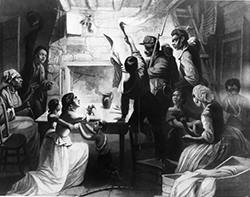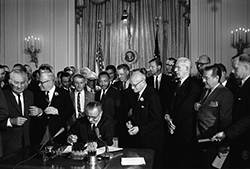
One hundred years separate the Emancipation Proclamation and the March on Washington. Yet, these two events are profoundly linked together in a larger story of liberty and the American experience. Both were the result of people demanding justice. Both grew out of decades of bold actions, resistance, organization, and vision. In both we take inspiration from those who marched toward freedom.
Changing America was created to commemorate these two pivotal achievements on their 150th and 50th anniversaries. It explores their historical context, their accomplishments and limitations, and their impact on the generations that followed.
Changing America: The Emancipation Proclamation, 1863 and the March on Washington, 1963 is presented by the Smithsonian’s National Museum of African American History and Culture and the National Museum of American History in collaboration with the American Library Association Public Programs Office. The tour of the traveling exhibition is made possible by the National Endowment for the Humanities: Exploring the Human Endeavor.
September 14, 2017
Grand opening of Changing America: The Emancipation Proclamation, 1863 and the March on Washington, 1963, featuring a “History Hop”
5:00 p.m. Exhibit Opening and Recption at the Historica Capitol Museum
5:30 p.m. Comments by Dr. Phyllis Gray-Ray
6:00 p.m. History Hop Tours Begin
Refreshments provided
Free and open to the public
Join us for an evening History Hop featuring the opening of the Smithsonian traveling exhibition Changing America: The Emancipation Proclamation, 1863 and the March on Washington, 1963. Learn about these pivotal national events from Dr. Phyllis Gray-Ray, Chair of Florida A&M University’s Department of Sociology and Criminal Justice, and then travel to historic locations to hear some of Tallahassee’s unique Civil War and Civil Rights stories.
Start at the Historic Capitol for all of the exhibit opening fun. Then at 6:00 p.m., travel on foot to the Union Bank and the Civil Rights Heritage Sidewalk or hop on the trolley running to and from The Grove Museum. Each site will offer a special experience.
September 21, 2017
Created Equal Film Series: Screening of The Loving Story
5:30 – 8:00 p.m., Film will begin at 6 p.m. (77 minute runtime), discussion to follow
Refreshments provided
Free and open to the public
Join us for a screening and discussion of The Loving Story, a film from the PBS Created Equal: America’s Civil Rights Struggle series, which brings four outstanding films on the civil rights movement to communities across the United States and encourages communities across the country to revisit and reflect on the long history of civil rights in America.
When Mildred and Richard Loving were arrested in July 1958, in Virginia, for violating a state law that banned marriage between people of different races, such laws had been on the books in most states since the seventeenth century. But the Lovings never expected to be woken up in their bedroom in the middle of the night and arrested. The documentary brings to life the Lovings’ marriage and the legal battle that followed through little-known filmed interviews and photographs shot for Life magazine.
Film will begin at 6 p.m. (77 minute runtime), with a discussion to follow led by Reginald K. Ellis, Associate Professor of History, Florida A&M University. The event is free and open to the public and refreshments will be served.
October 5, 2017
Lift Every Voice: A Musical Evening With Avis Berry
Time: Exhibition open from 5:30 p.m., Musical program to begin at 6 p.m.
Refreshments provided
Free and open to the public
Music played a vital role in the fight against slavery, as well as encouraging the march towards freedom and equality in the 1960s. The rousing sounds of spirituals, gospel, and folk music served many purposes in these times of struggle—strength and motivation, healing and comfort, or joy and celebration. Join us for a musical evening with local singer, Avis Berry as she performs the empowering songs of the African American experience.













